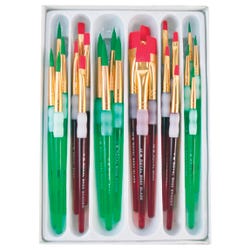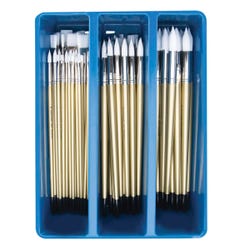Van Gogh's Trees

Description
Lesson Plan & Artwork by: Meredith Ose
This lesson is inspired by the various tree painting of Impressionist painter Vincent Van Gogh. The works are especially characteristic of his bold use of colors, frequent complementary use of orange and blue, and thick application of paint in multiple layers of short lines. Van Gogh's paintings were created by building up the canvas with paint. He built the structures of each subject with each thick stroke. Van Gogh's paintings are also characteristic of the use of visual movement. The paintings often show movement in the atmosphere, but you can also feel the movement in the subject matter because of his thick application of paint and short brush strokes of curves and dashes flowing in organic directions and following the shapes of objects. The tree theme runs throughout his body of work, from earliest works to some of the last paintings created at the end of his life.
Objectives
- Students will create a painting in an Impressionistic style.
- Students will gain an appreciation for the works of Vincent Van Gogh.
- Students will understand properties of trees and landscapes and their relationship with the light at different times of day and times of year.
- Students will observe actual landscapes in their environment and create original images.
Supplies Needed
Royal® Brush Artist Acrylic Paint, 120ml, Set of 12 1471233
Royal® Brush Snowhite Classroom Caddie, Set of 72 1289613
Royal® Big Kid's Choice Combo Classroom Caddie, Set of 72 1440157
Royal® Collapsible Brush Bucket 1470937
Sax® 140lb. Watercolor Paper, Pack of 100 358445
*Here are the supplies needed for this lesson plan for reference. Find a convenient carousel of shoppable products for this lesson below.
Standards
Standard #1: Generate and conceptualize artistic ideas and work.
Standard #2: Organize and develop artistic ideas and work.
Standard #10: Synthesize and relate knowledge and personal experiences to make art.
Instructions
1
Compare several types of trees; use Van Gogh's tree paintings as a source as well as actual trees in your environment. Go outside and make study drawings of various trees and landscapes. Explore the space you have outside the classroom - go on a walking landscape field trip.
2
Practice drawing the trees with texture. Draw short dash lines in the direction of the shape of the trees, grasses, landscape, use opposite directional lines for the background to create definition of space.
3
Choose the best image for your painting. Begin with the lightest color in your palette. Using a palette of primary colors, begin with any yellow color and map out your painting all in yellow.
4
Start building up the painting and defining subject matter such as trees, hillsides, grasses, clouds, and the sky with small amounts of colors other than the ones used in the last step. Use a slightly darker set of colors from your primary palette to build each additional layer on the painting. Using one of the small flat brushes will help create the short paint strokes that are characteristic of Van Gogh's painting style. Use complementary colors like orange and blue.
5
Keep building and adding more short strokes. Finish by adding the darkest and brightest colors to define, add contrast, and to emphasize the subject matter. Try not to mix colors exactly how you want to see them on your palette. Instead, use the building technique of short brush strokes of colors next to each other as if you are mixing them on the canvas, visually mixing colors by placing them next to each other.
Notes: You may use water to help create a smooth consistency but keep the paint rather thick for the final painting. Using smaller synthetic brushes for a small canvas size will also help students maintain the Impressionistic style of Van Gogh. Use several different pictures of trees, landscapes, and orchards. Show several different images of Van Gogh's paintings. Create a hand out on the history and background of Vincent Van Gogh.







